ASDA: Critical Analysis of Operational Changes and Performance
VerifiedAdded on 2020/01/07
|31
|4545
|164
Report
AI Summary
This report critically analyzes ASDA's business performance, focusing on operational changes, investment appraisal, and project risk management. It begins with an introduction to ASDA and assesses potential changes to improve operational performance, including technological advancements, transportation system improvements, and CRM strategies. The report then evaluates investment appraisal techniques, selecting Net Present Value (NPV) as the most suitable method for evaluating changes. It further explores radical change and continuous improvement theories, recommending the use of continuous improvement techniques for ASDA. The report also addresses project risk, identifying various risk factors and analysis methods. Finally, the report includes a project plan, Gantt chart, and network diagram, constructed using MS Project, to provide a practical framework for implementing the recommended changes.
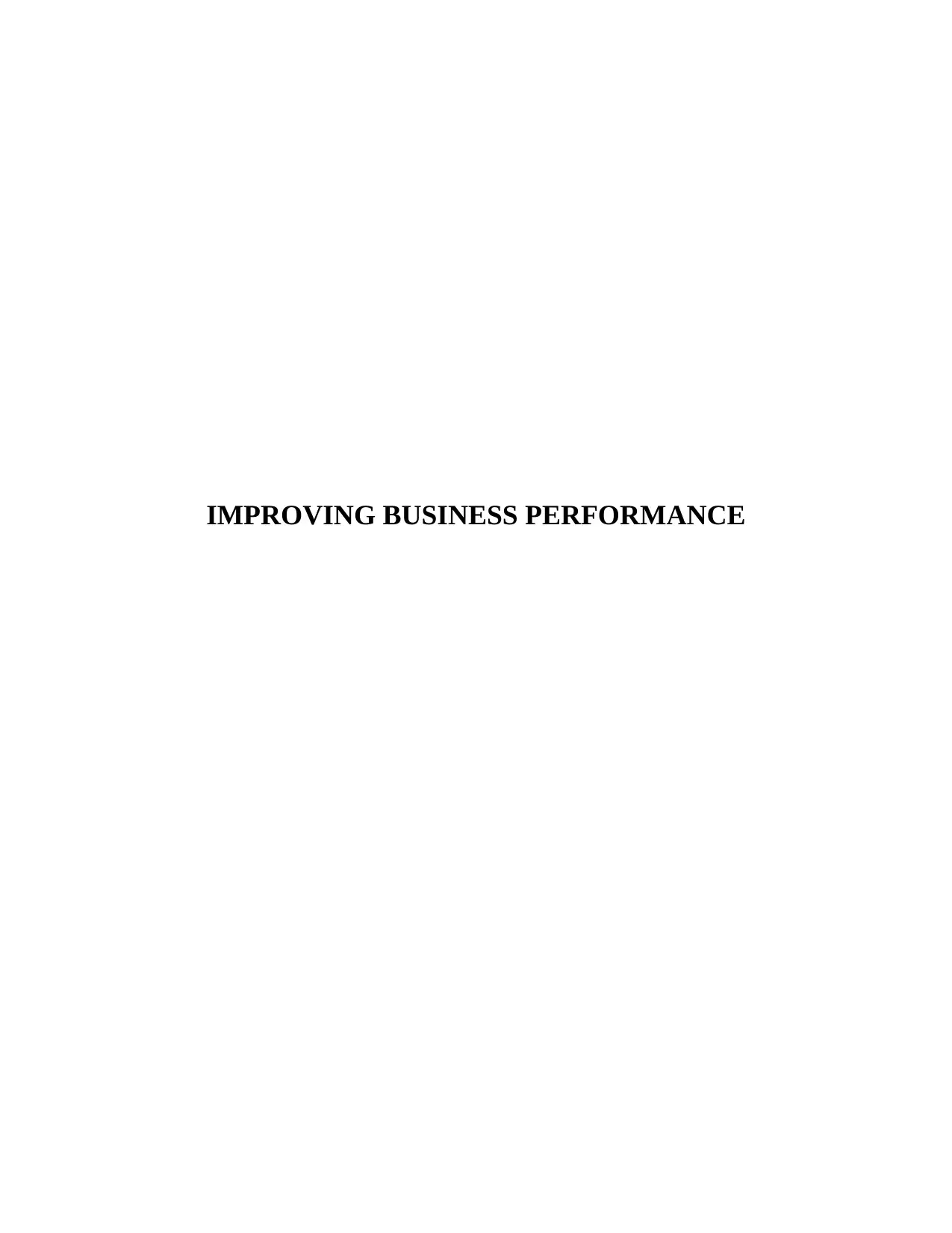
IMPROVING BUSINESS PERFORMANCE
Paraphrase This Document
Need a fresh take? Get an instant paraphrase of this document with our AI Paraphraser
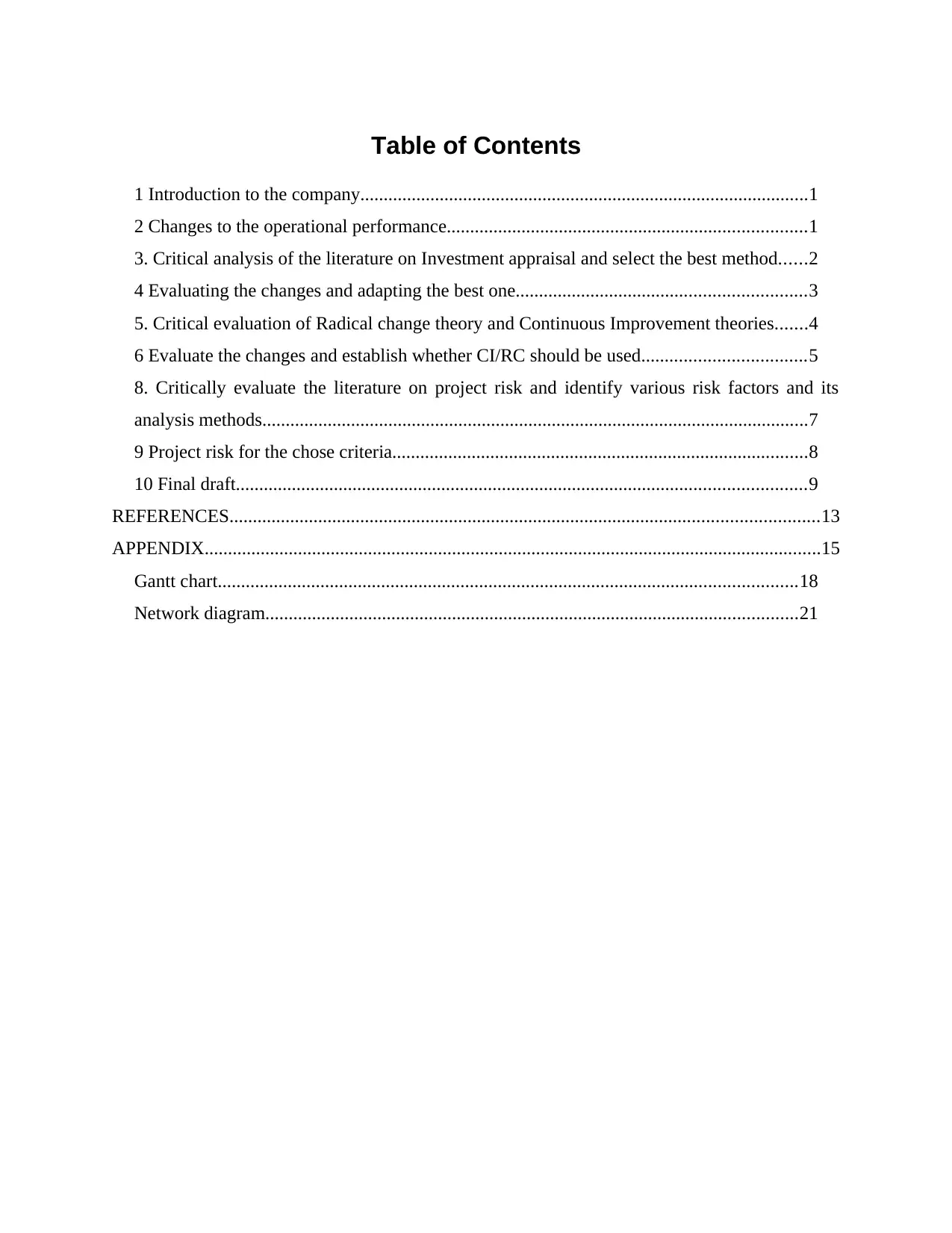
Table of Contents
1 Introduction to the company................................................................................................1
2 Changes to the operational performance.............................................................................1
3. Critical analysis of the literature on Investment appraisal and select the best method......2
4 Evaluating the changes and adapting the best one..............................................................3
5. Critical evaluation of Radical change theory and Continuous Improvement theories.......4
6 Evaluate the changes and establish whether CI/RC should be used...................................5
8. Critically evaluate the literature on project risk and identify various risk factors and its
analysis methods.....................................................................................................................7
9 Project risk for the chose criteria.........................................................................................8
10 Final draft..........................................................................................................................9
REFERENCES..............................................................................................................................13
APPENDIX....................................................................................................................................15
Gantt chart............................................................................................................................18
Network diagram..................................................................................................................21
1 Introduction to the company................................................................................................1
2 Changes to the operational performance.............................................................................1
3. Critical analysis of the literature on Investment appraisal and select the best method......2
4 Evaluating the changes and adapting the best one..............................................................3
5. Critical evaluation of Radical change theory and Continuous Improvement theories.......4
6 Evaluate the changes and establish whether CI/RC should be used...................................5
8. Critically evaluate the literature on project risk and identify various risk factors and its
analysis methods.....................................................................................................................7
9 Project risk for the chose criteria.........................................................................................8
10 Final draft..........................................................................................................................9
REFERENCES..............................................................................................................................13
APPENDIX....................................................................................................................................15
Gantt chart............................................................................................................................18
Network diagram..................................................................................................................21
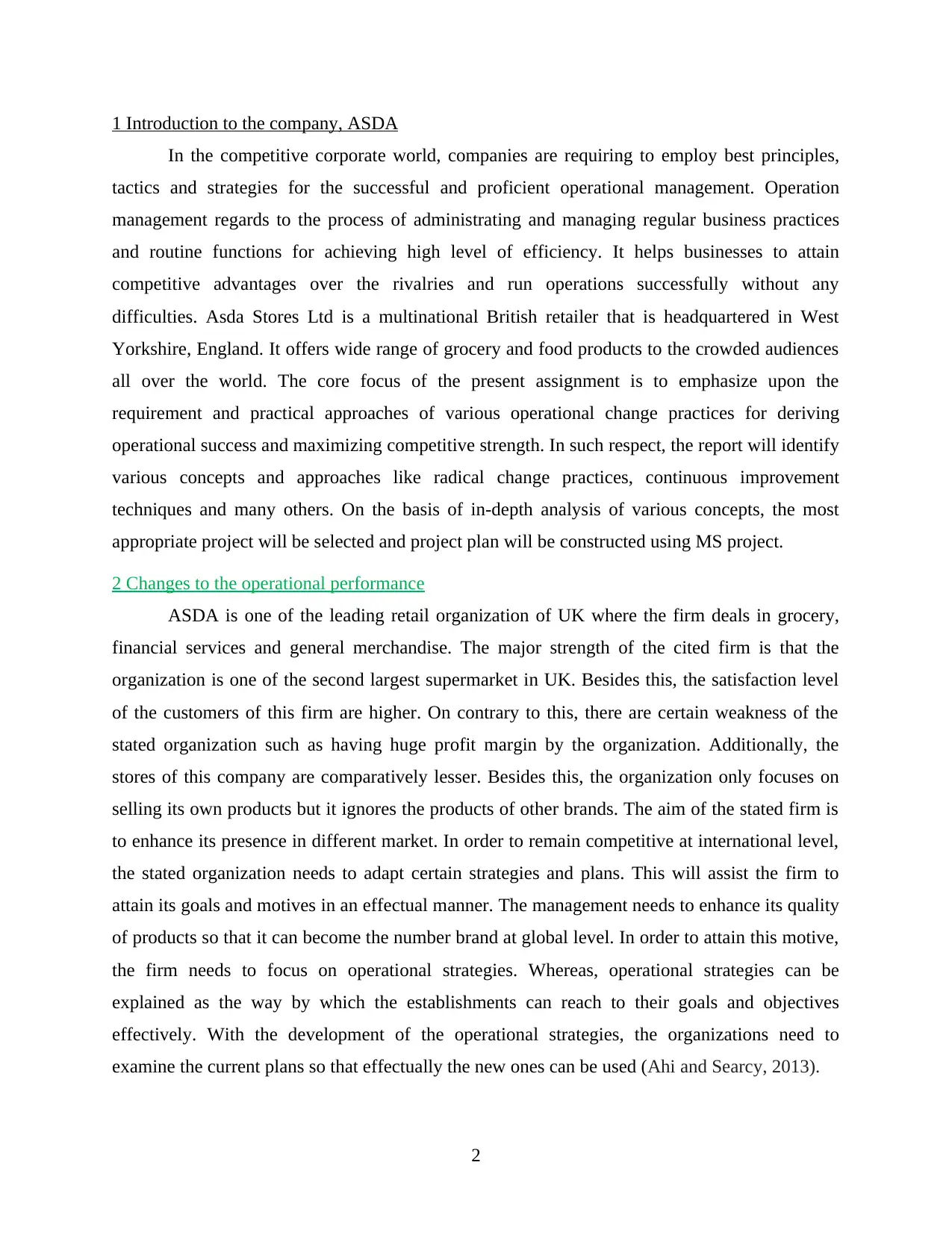
1 Introduction to the company, ASDA
In the competitive corporate world, companies are requiring to employ best principles,
tactics and strategies for the successful and proficient operational management. Operation
management regards to the process of administrating and managing regular business practices
and routine functions for achieving high level of efficiency. It helps businesses to attain
competitive advantages over the rivalries and run operations successfully without any
difficulties. Asda Stores Ltd is a multinational British retailer that is headquartered in West
Yorkshire, England. It offers wide range of grocery and food products to the crowded audiences
all over the world. The core focus of the present assignment is to emphasize upon the
requirement and practical approaches of various operational change practices for deriving
operational success and maximizing competitive strength. In such respect, the report will identify
various concepts and approaches like radical change practices, continuous improvement
techniques and many others. On the basis of in-depth analysis of various concepts, the most
appropriate project will be selected and project plan will be constructed using MS project.
2 Changes to the operational performance
ASDA is one of the leading retail organization of UK where the firm deals in grocery,
financial services and general merchandise. The major strength of the cited firm is that the
organization is one of the second largest supermarket in UK. Besides this, the satisfaction level
of the customers of this firm are higher. On contrary to this, there are certain weakness of the
stated organization such as having huge profit margin by the organization. Additionally, the
stores of this company are comparatively lesser. Besides this, the organization only focuses on
selling its own products but it ignores the products of other brands. The aim of the stated firm is
to enhance its presence in different market. In order to remain competitive at international level,
the stated organization needs to adapt certain strategies and plans. This will assist the firm to
attain its goals and motives in an effectual manner. The management needs to enhance its quality
of products so that it can become the number brand at global level. In order to attain this motive,
the firm needs to focus on operational strategies. Whereas, operational strategies can be
explained as the way by which the establishments can reach to their goals and objectives
effectively. With the development of the operational strategies, the organizations need to
examine the current plans so that effectually the new ones can be used (Ahi and Searcy, 2013).
2
In the competitive corporate world, companies are requiring to employ best principles,
tactics and strategies for the successful and proficient operational management. Operation
management regards to the process of administrating and managing regular business practices
and routine functions for achieving high level of efficiency. It helps businesses to attain
competitive advantages over the rivalries and run operations successfully without any
difficulties. Asda Stores Ltd is a multinational British retailer that is headquartered in West
Yorkshire, England. It offers wide range of grocery and food products to the crowded audiences
all over the world. The core focus of the present assignment is to emphasize upon the
requirement and practical approaches of various operational change practices for deriving
operational success and maximizing competitive strength. In such respect, the report will identify
various concepts and approaches like radical change practices, continuous improvement
techniques and many others. On the basis of in-depth analysis of various concepts, the most
appropriate project will be selected and project plan will be constructed using MS project.
2 Changes to the operational performance
ASDA is one of the leading retail organization of UK where the firm deals in grocery,
financial services and general merchandise. The major strength of the cited firm is that the
organization is one of the second largest supermarket in UK. Besides this, the satisfaction level
of the customers of this firm are higher. On contrary to this, there are certain weakness of the
stated organization such as having huge profit margin by the organization. Additionally, the
stores of this company are comparatively lesser. Besides this, the organization only focuses on
selling its own products but it ignores the products of other brands. The aim of the stated firm is
to enhance its presence in different market. In order to remain competitive at international level,
the stated organization needs to adapt certain strategies and plans. This will assist the firm to
attain its goals and motives in an effectual manner. The management needs to enhance its quality
of products so that it can become the number brand at global level. In order to attain this motive,
the firm needs to focus on operational strategies. Whereas, operational strategies can be
explained as the way by which the establishments can reach to their goals and objectives
effectively. With the development of the operational strategies, the organizations need to
examine the current plans so that effectually the new ones can be used (Ahi and Searcy, 2013).
2
⊘ This is a preview!⊘
Do you want full access?
Subscribe today to unlock all pages.

Trusted by 1+ million students worldwide
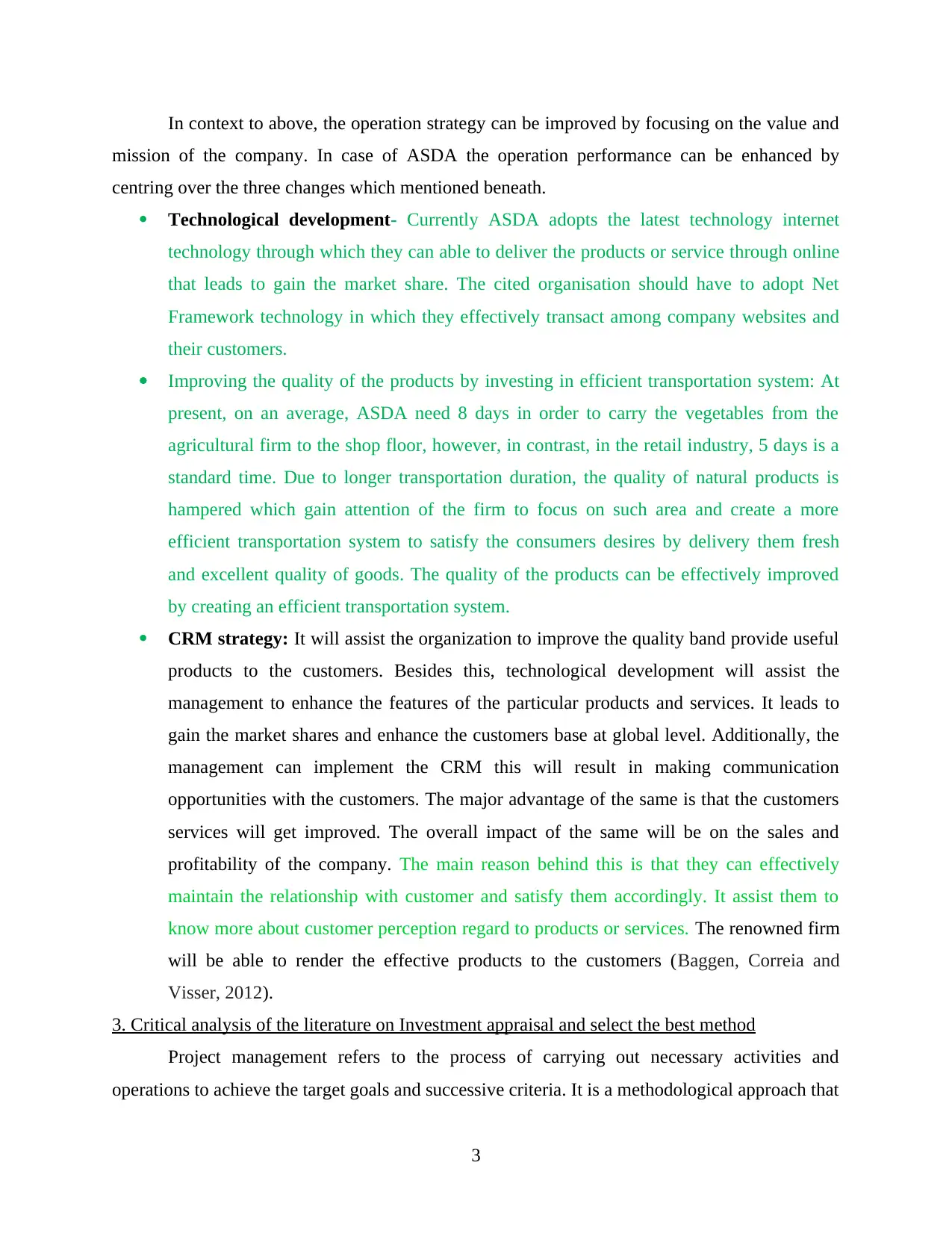
In context to above, the operation strategy can be improved by focusing on the value and
mission of the company. In case of ASDA the operation performance can be enhanced by
centring over the three changes which mentioned beneath.
Technological development- Currently ASDA adopts the latest technology internet
technology through which they can able to deliver the products or service through online
that leads to gain the market share. The cited organisation should have to adopt Net
Framework technology in which they effectively transact among company websites and
their customers.
Improving the quality of the products by investing in efficient transportation system: At
present, on an average, ASDA need 8 days in order to carry the vegetables from the
agricultural firm to the shop floor, however, in contrast, in the retail industry, 5 days is a
standard time. Due to longer transportation duration, the quality of natural products is
hampered which gain attention of the firm to focus on such area and create a more
efficient transportation system to satisfy the consumers desires by delivery them fresh
and excellent quality of goods. The quality of the products can be effectively improved
by creating an efficient transportation system.
CRM strategy: It will assist the organization to improve the quality band provide useful
products to the customers. Besides this, technological development will assist the
management to enhance the features of the particular products and services. It leads to
gain the market shares and enhance the customers base at global level. Additionally, the
management can implement the CRM this will result in making communication
opportunities with the customers. The major advantage of the same is that the customers
services will get improved. The overall impact of the same will be on the sales and
profitability of the company. The main reason behind this is that they can effectively
maintain the relationship with customer and satisfy them accordingly. It assist them to
know more about customer perception regard to products or services. The renowned firm
will be able to render the effective products to the customers (Baggen, Correia and
Visser, 2012).
3. Critical analysis of the literature on Investment appraisal and select the best method
Project management refers to the process of carrying out necessary activities and
operations to achieve the target goals and successive criteria. It is a methodological approach that
3
mission of the company. In case of ASDA the operation performance can be enhanced by
centring over the three changes which mentioned beneath.
Technological development- Currently ASDA adopts the latest technology internet
technology through which they can able to deliver the products or service through online
that leads to gain the market share. The cited organisation should have to adopt Net
Framework technology in which they effectively transact among company websites and
their customers.
Improving the quality of the products by investing in efficient transportation system: At
present, on an average, ASDA need 8 days in order to carry the vegetables from the
agricultural firm to the shop floor, however, in contrast, in the retail industry, 5 days is a
standard time. Due to longer transportation duration, the quality of natural products is
hampered which gain attention of the firm to focus on such area and create a more
efficient transportation system to satisfy the consumers desires by delivery them fresh
and excellent quality of goods. The quality of the products can be effectively improved
by creating an efficient transportation system.
CRM strategy: It will assist the organization to improve the quality band provide useful
products to the customers. Besides this, technological development will assist the
management to enhance the features of the particular products and services. It leads to
gain the market shares and enhance the customers base at global level. Additionally, the
management can implement the CRM this will result in making communication
opportunities with the customers. The major advantage of the same is that the customers
services will get improved. The overall impact of the same will be on the sales and
profitability of the company. The main reason behind this is that they can effectively
maintain the relationship with customer and satisfy them accordingly. It assist them to
know more about customer perception regard to products or services. The renowned firm
will be able to render the effective products to the customers (Baggen, Correia and
Visser, 2012).
3. Critical analysis of the literature on Investment appraisal and select the best method
Project management refers to the process of carrying out necessary activities and
operations to achieve the target goals and successive criteria. It is a methodological approach that
3
Paraphrase This Document
Need a fresh take? Get an instant paraphrase of this document with our AI Paraphraser
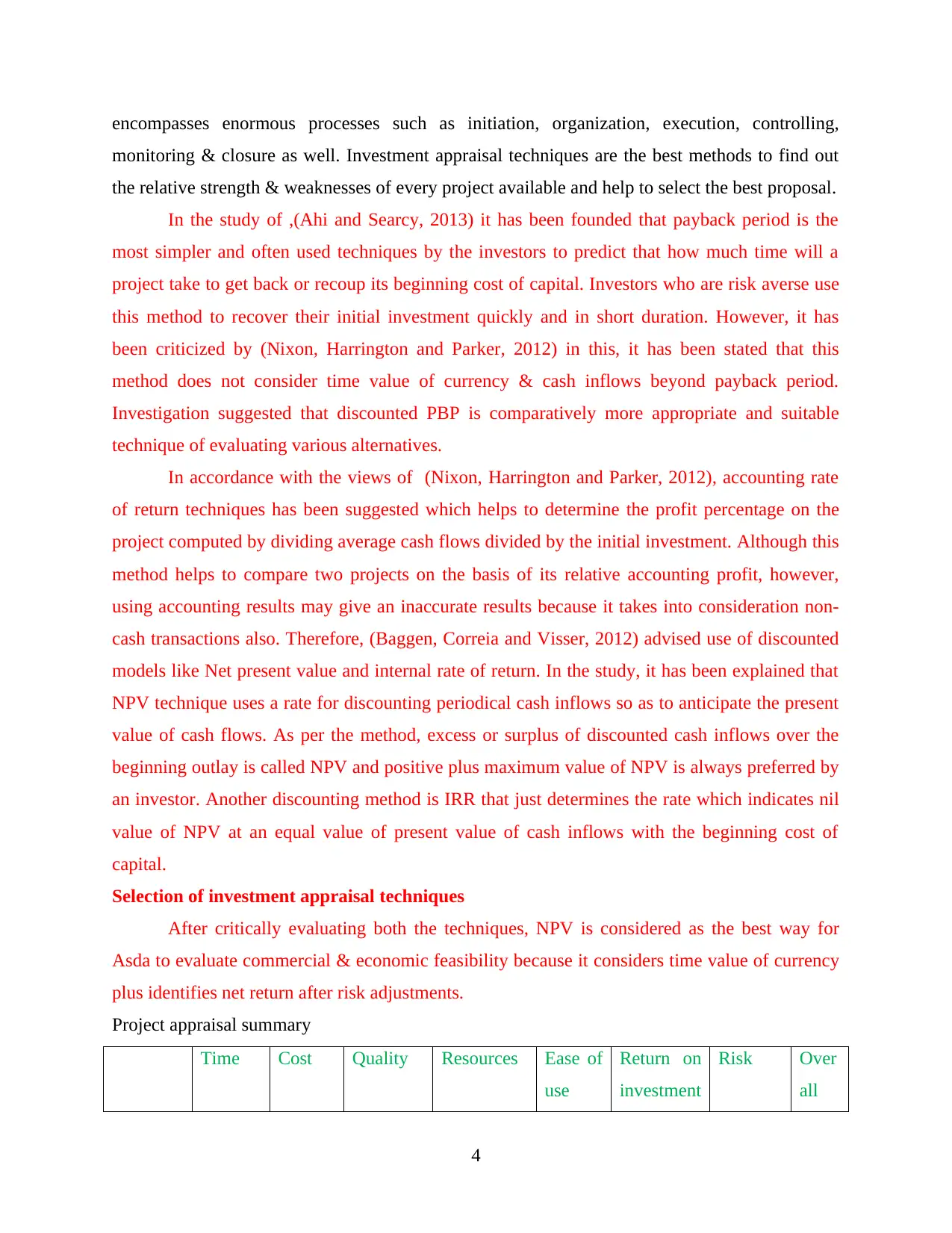
encompasses enormous processes such as initiation, organization, execution, controlling,
monitoring & closure as well. Investment appraisal techniques are the best methods to find out
the relative strength & weaknesses of every project available and help to select the best proposal.
In the study of ,(Ahi and Searcy, 2013) it has been founded that payback period is the
most simpler and often used techniques by the investors to predict that how much time will a
project take to get back or recoup its beginning cost of capital. Investors who are risk averse use
this method to recover their initial investment quickly and in short duration. However, it has
been criticized by (Nixon, Harrington and Parker, 2012) in this, it has been stated that this
method does not consider time value of currency & cash inflows beyond payback period.
Investigation suggested that discounted PBP is comparatively more appropriate and suitable
technique of evaluating various alternatives.
In accordance with the views of (Nixon, Harrington and Parker, 2012), accounting rate
of return techniques has been suggested which helps to determine the profit percentage on the
project computed by dividing average cash flows divided by the initial investment. Although this
method helps to compare two projects on the basis of its relative accounting profit, however,
using accounting results may give an inaccurate results because it takes into consideration non-
cash transactions also. Therefore, (Baggen, Correia and Visser, 2012) advised use of discounted
models like Net present value and internal rate of return. In the study, it has been explained that
NPV technique uses a rate for discounting periodical cash inflows so as to anticipate the present
value of cash flows. As per the method, excess or surplus of discounted cash inflows over the
beginning outlay is called NPV and positive plus maximum value of NPV is always preferred by
an investor. Another discounting method is IRR that just determines the rate which indicates nil
value of NPV at an equal value of present value of cash inflows with the beginning cost of
capital.
Selection of investment appraisal techniques
After critically evaluating both the techniques, NPV is considered as the best way for
Asda to evaluate commercial & economic feasibility because it considers time value of currency
plus identifies net return after risk adjustments.
Project appraisal summary
Time Cost Quality Resources Ease of
use
Return on
investment
Risk Over
all
4
monitoring & closure as well. Investment appraisal techniques are the best methods to find out
the relative strength & weaknesses of every project available and help to select the best proposal.
In the study of ,(Ahi and Searcy, 2013) it has been founded that payback period is the
most simpler and often used techniques by the investors to predict that how much time will a
project take to get back or recoup its beginning cost of capital. Investors who are risk averse use
this method to recover their initial investment quickly and in short duration. However, it has
been criticized by (Nixon, Harrington and Parker, 2012) in this, it has been stated that this
method does not consider time value of currency & cash inflows beyond payback period.
Investigation suggested that discounted PBP is comparatively more appropriate and suitable
technique of evaluating various alternatives.
In accordance with the views of (Nixon, Harrington and Parker, 2012), accounting rate
of return techniques has been suggested which helps to determine the profit percentage on the
project computed by dividing average cash flows divided by the initial investment. Although this
method helps to compare two projects on the basis of its relative accounting profit, however,
using accounting results may give an inaccurate results because it takes into consideration non-
cash transactions also. Therefore, (Baggen, Correia and Visser, 2012) advised use of discounted
models like Net present value and internal rate of return. In the study, it has been explained that
NPV technique uses a rate for discounting periodical cash inflows so as to anticipate the present
value of cash flows. As per the method, excess or surplus of discounted cash inflows over the
beginning outlay is called NPV and positive plus maximum value of NPV is always preferred by
an investor. Another discounting method is IRR that just determines the rate which indicates nil
value of NPV at an equal value of present value of cash inflows with the beginning cost of
capital.
Selection of investment appraisal techniques
After critically evaluating both the techniques, NPV is considered as the best way for
Asda to evaluate commercial & economic feasibility because it considers time value of currency
plus identifies net return after risk adjustments.
Project appraisal summary
Time Cost Quality Resources Ease of
use
Return on
investment
Risk Over
all
4
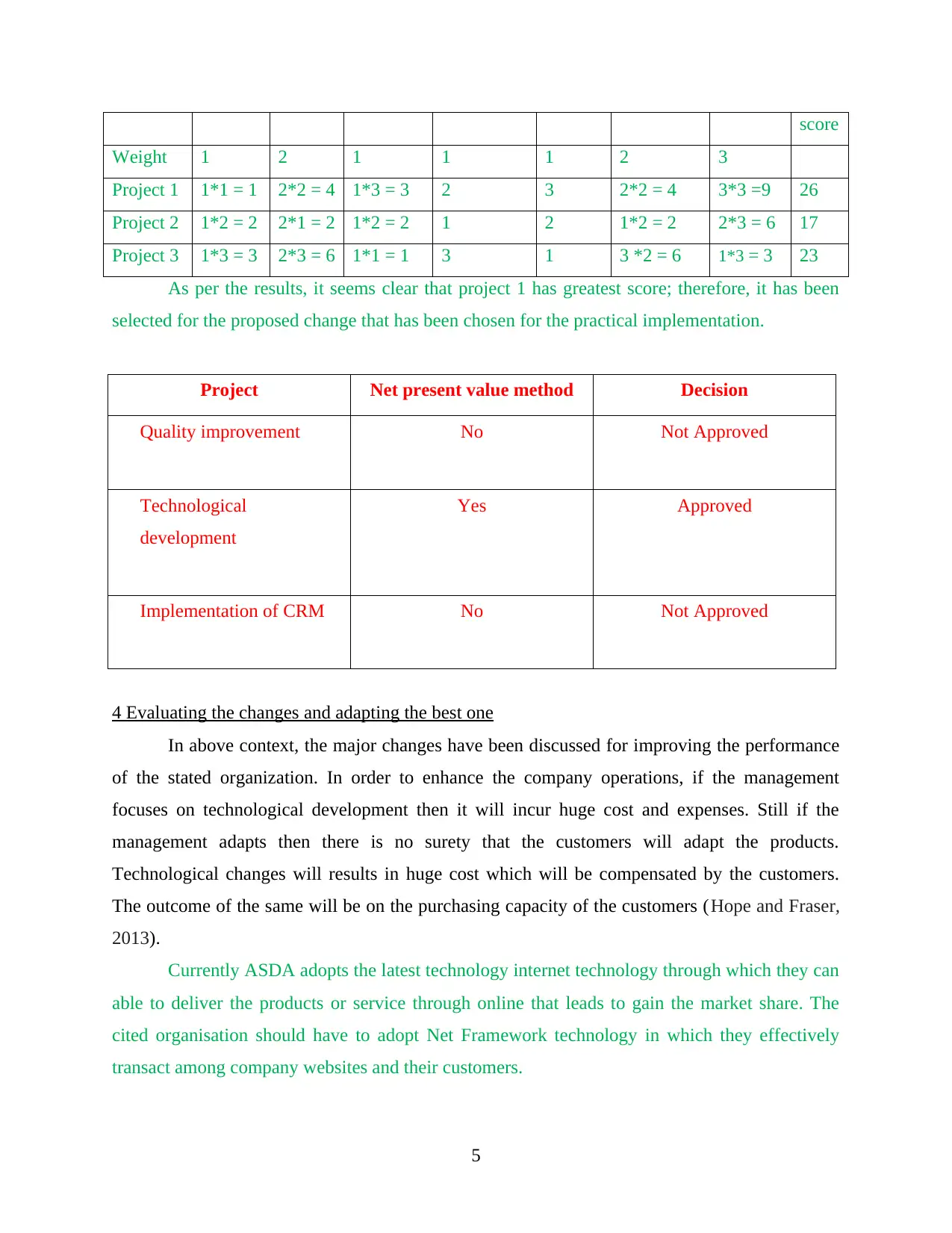
score
Weight 1 2 1 1 1 2 3
Project 1 1*1 = 1 2*2 = 4 1*3 = 3 2 3 2*2 = 4 3*3 =9 26
Project 2 1*2 = 2 2*1 = 2 1*2 = 2 1 2 1*2 = 2 2*3 = 6 17
Project 3 1*3 = 3 2*3 = 6 1*1 = 1 3 1 3 *2 = 6 1*3 = 3 23
As per the results, it seems clear that project 1 has greatest score; therefore, it has been
selected for the proposed change that has been chosen for the practical implementation.
Project Net present value method Decision
Quality improvement No Not Approved
Technological
development
Yes Approved
Implementation of CRM No Not Approved
4 Evaluating the changes and adapting the best one
In above context, the major changes have been discussed for improving the performance
of the stated organization. In order to enhance the company operations, if the management
focuses on technological development then it will incur huge cost and expenses. Still if the
management adapts then there is no surety that the customers will adapt the products.
Technological changes will results in huge cost which will be compensated by the customers.
The outcome of the same will be on the purchasing capacity of the customers (Hope and Fraser,
2013).
Currently ASDA adopts the latest technology internet technology through which they can
able to deliver the products or service through online that leads to gain the market share. The
cited organisation should have to adopt Net Framework technology in which they effectively
transact among company websites and their customers.
5
Weight 1 2 1 1 1 2 3
Project 1 1*1 = 1 2*2 = 4 1*3 = 3 2 3 2*2 = 4 3*3 =9 26
Project 2 1*2 = 2 2*1 = 2 1*2 = 2 1 2 1*2 = 2 2*3 = 6 17
Project 3 1*3 = 3 2*3 = 6 1*1 = 1 3 1 3 *2 = 6 1*3 = 3 23
As per the results, it seems clear that project 1 has greatest score; therefore, it has been
selected for the proposed change that has been chosen for the practical implementation.
Project Net present value method Decision
Quality improvement No Not Approved
Technological
development
Yes Approved
Implementation of CRM No Not Approved
4 Evaluating the changes and adapting the best one
In above context, the major changes have been discussed for improving the performance
of the stated organization. In order to enhance the company operations, if the management
focuses on technological development then it will incur huge cost and expenses. Still if the
management adapts then there is no surety that the customers will adapt the products.
Technological changes will results in huge cost which will be compensated by the customers.
The outcome of the same will be on the purchasing capacity of the customers (Hope and Fraser,
2013).
Currently ASDA adopts the latest technology internet technology through which they can
able to deliver the products or service through online that leads to gain the market share. The
cited organisation should have to adopt Net Framework technology in which they effectively
transact among company websites and their customers.
5
⊘ This is a preview!⊘
Do you want full access?
Subscribe today to unlock all pages.

Trusted by 1+ million students worldwide
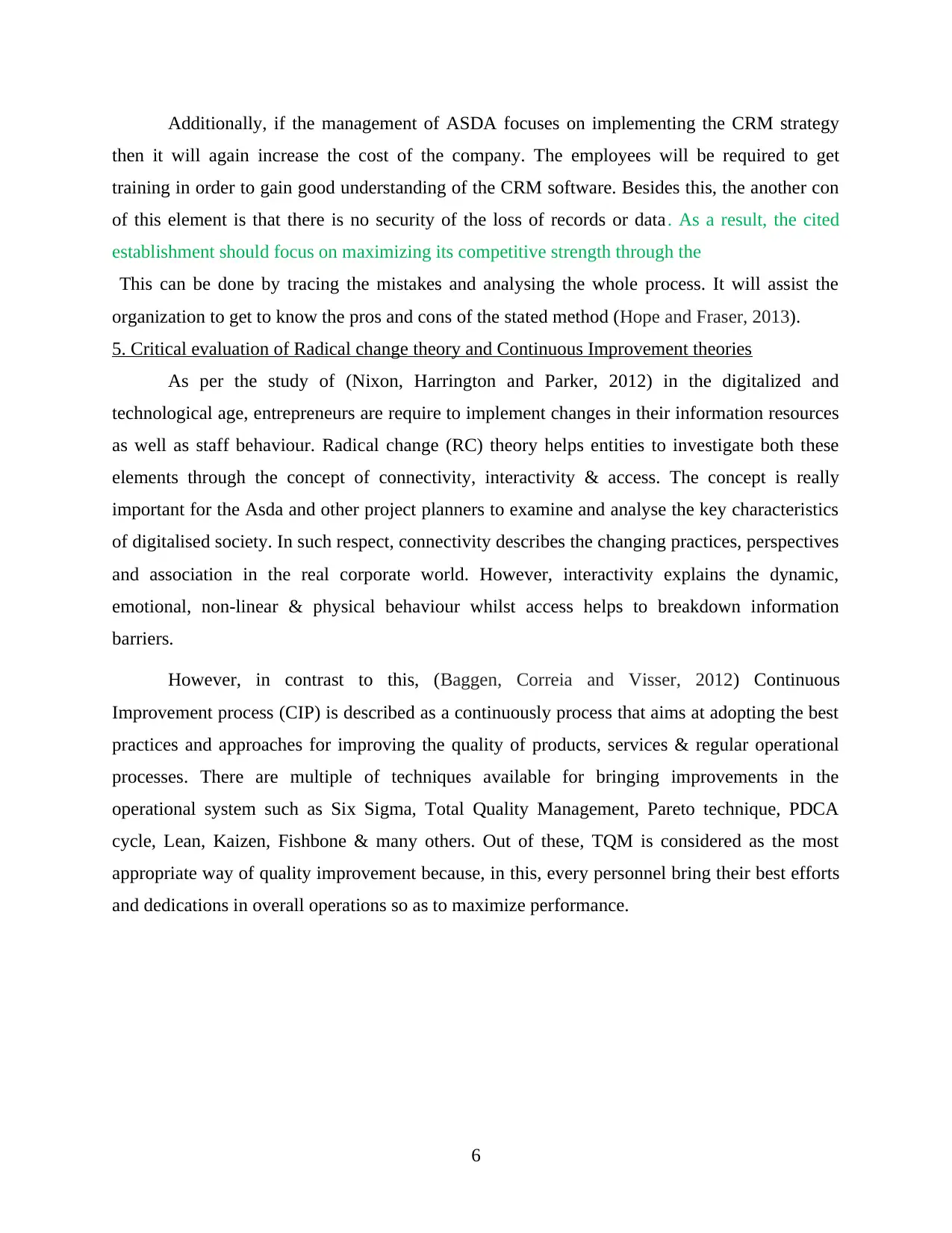
Additionally, if the management of ASDA focuses on implementing the CRM strategy
then it will again increase the cost of the company. The employees will be required to get
training in order to gain good understanding of the CRM software. Besides this, the another con
of this element is that there is no security of the loss of records or data. As a result, the cited
establishment should focus on maximizing its competitive strength through the
This can be done by tracing the mistakes and analysing the whole process. It will assist the
organization to get to know the pros and cons of the stated method (Hope and Fraser, 2013).
5. Critical evaluation of Radical change theory and Continuous Improvement theories
As per the study of (Nixon, Harrington and Parker, 2012) in the digitalized and
technological age, entrepreneurs are require to implement changes in their information resources
as well as staff behaviour. Radical change (RC) theory helps entities to investigate both these
elements through the concept of connectivity, interactivity & access. The concept is really
important for the Asda and other project planners to examine and analyse the key characteristics
of digitalised society. In such respect, connectivity describes the changing practices, perspectives
and association in the real corporate world. However, interactivity explains the dynamic,
emotional, non-linear & physical behaviour whilst access helps to breakdown information
barriers.
However, in contrast to this, (Baggen, Correia and Visser, 2012) Continuous
Improvement process (CIP) is described as a continuously process that aims at adopting the best
practices and approaches for improving the quality of products, services & regular operational
processes. There are multiple of techniques available for bringing improvements in the
operational system such as Six Sigma, Total Quality Management, Pareto technique, PDCA
cycle, Lean, Kaizen, Fishbone & many others. Out of these, TQM is considered as the most
appropriate way of quality improvement because, in this, every personnel bring their best efforts
and dedications in overall operations so as to maximize performance.
6
then it will again increase the cost of the company. The employees will be required to get
training in order to gain good understanding of the CRM software. Besides this, the another con
of this element is that there is no security of the loss of records or data. As a result, the cited
establishment should focus on maximizing its competitive strength through the
This can be done by tracing the mistakes and analysing the whole process. It will assist the
organization to get to know the pros and cons of the stated method (Hope and Fraser, 2013).
5. Critical evaluation of Radical change theory and Continuous Improvement theories
As per the study of (Nixon, Harrington and Parker, 2012) in the digitalized and
technological age, entrepreneurs are require to implement changes in their information resources
as well as staff behaviour. Radical change (RC) theory helps entities to investigate both these
elements through the concept of connectivity, interactivity & access. The concept is really
important for the Asda and other project planners to examine and analyse the key characteristics
of digitalised society. In such respect, connectivity describes the changing practices, perspectives
and association in the real corporate world. However, interactivity explains the dynamic,
emotional, non-linear & physical behaviour whilst access helps to breakdown information
barriers.
However, in contrast to this, (Baggen, Correia and Visser, 2012) Continuous
Improvement process (CIP) is described as a continuously process that aims at adopting the best
practices and approaches for improving the quality of products, services & regular operational
processes. There are multiple of techniques available for bringing improvements in the
operational system such as Six Sigma, Total Quality Management, Pareto technique, PDCA
cycle, Lean, Kaizen, Fishbone & many others. Out of these, TQM is considered as the most
appropriate way of quality improvement because, in this, every personnel bring their best efforts
and dedications in overall operations so as to maximize performance.
6
Paraphrase This Document
Need a fresh take? Get an instant paraphrase of this document with our AI Paraphraser
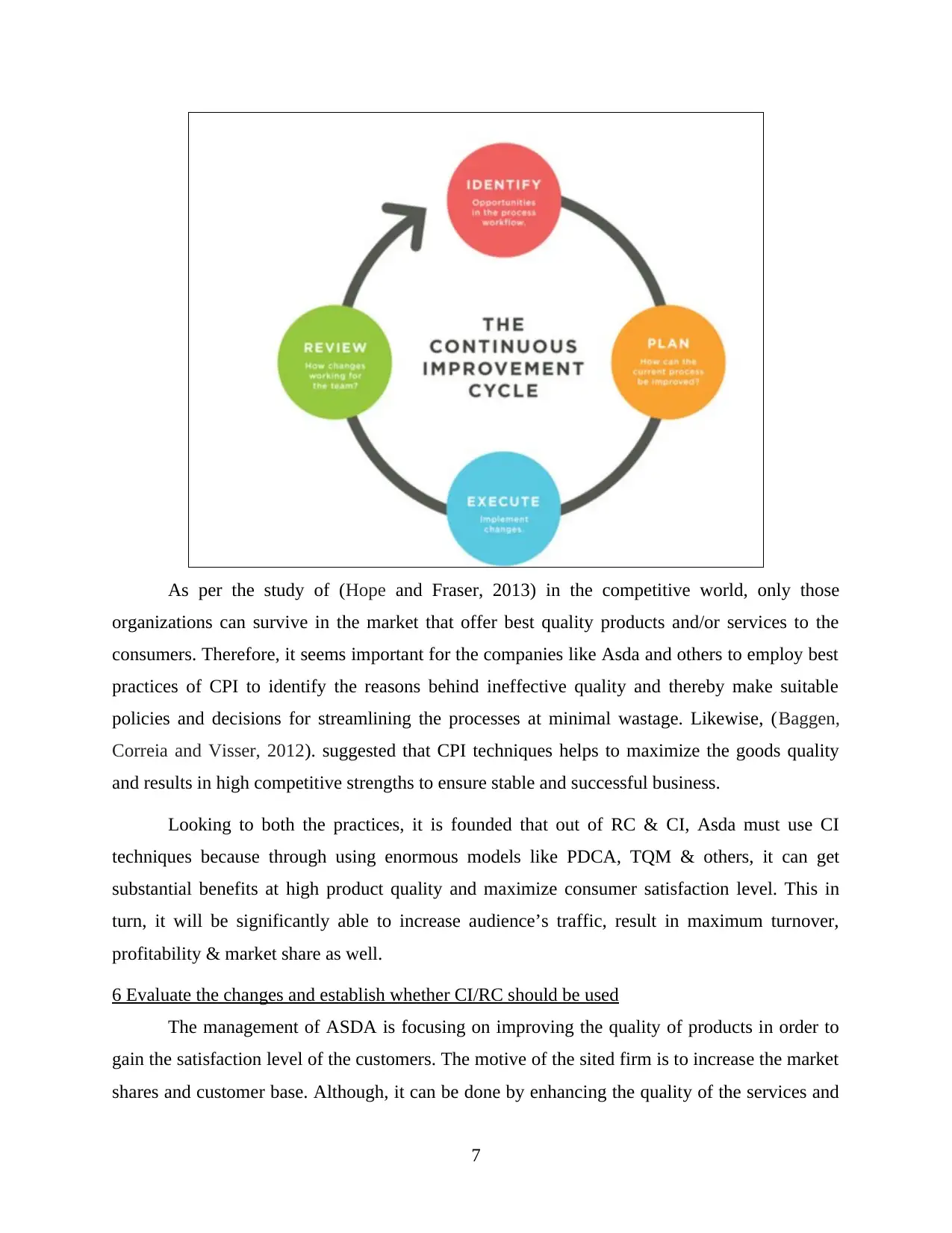
As per the study of (Hope and Fraser, 2013) in the competitive world, only those
organizations can survive in the market that offer best quality products and/or services to the
consumers. Therefore, it seems important for the companies like Asda and others to employ best
practices of CPI to identify the reasons behind ineffective quality and thereby make suitable
policies and decisions for streamlining the processes at minimal wastage. Likewise, (Baggen,
Correia and Visser, 2012). suggested that CPI techniques helps to maximize the goods quality
and results in high competitive strengths to ensure stable and successful business.
Looking to both the practices, it is founded that out of RC & CI, Asda must use CI
techniques because through using enormous models like PDCA, TQM & others, it can get
substantial benefits at high product quality and maximize consumer satisfaction level. This in
turn, it will be significantly able to increase audience’s traffic, result in maximum turnover,
profitability & market share as well.
6 Evaluate the changes and establish whether CI/RC should be used
The management of ASDA is focusing on improving the quality of products in order to
gain the satisfaction level of the customers. The motive of the sited firm is to increase the market
shares and customer base. Although, it can be done by enhancing the quality of the services and
7
organizations can survive in the market that offer best quality products and/or services to the
consumers. Therefore, it seems important for the companies like Asda and others to employ best
practices of CPI to identify the reasons behind ineffective quality and thereby make suitable
policies and decisions for streamlining the processes at minimal wastage. Likewise, (Baggen,
Correia and Visser, 2012). suggested that CPI techniques helps to maximize the goods quality
and results in high competitive strengths to ensure stable and successful business.
Looking to both the practices, it is founded that out of RC & CI, Asda must use CI
techniques because through using enormous models like PDCA, TQM & others, it can get
substantial benefits at high product quality and maximize consumer satisfaction level. This in
turn, it will be significantly able to increase audience’s traffic, result in maximum turnover,
profitability & market share as well.
6 Evaluate the changes and establish whether CI/RC should be used
The management of ASDA is focusing on improving the quality of products in order to
gain the satisfaction level of the customers. The motive of the sited firm is to increase the market
shares and customer base. Although, it can be done by enhancing the quality of the services and
7
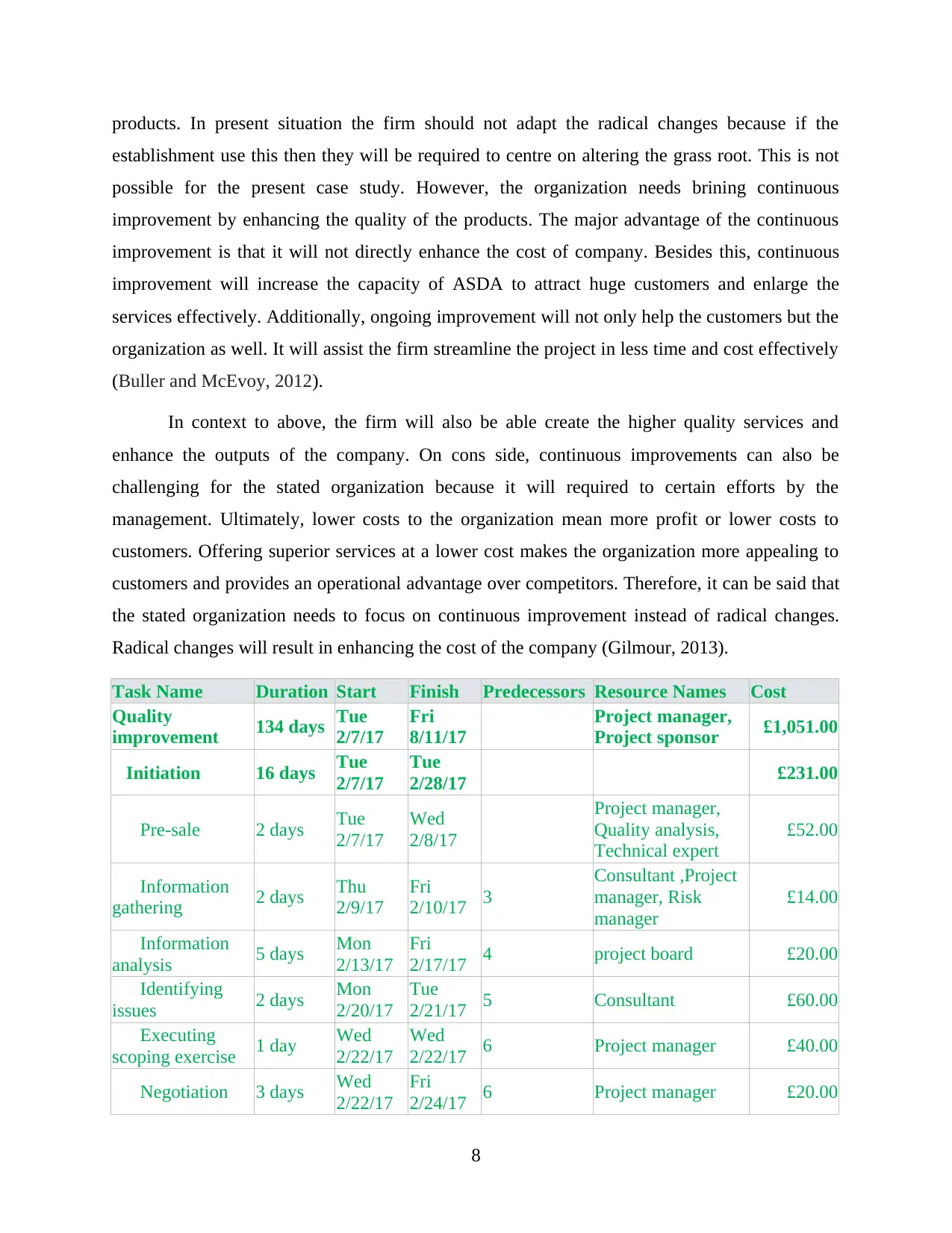
products. In present situation the firm should not adapt the radical changes because if the
establishment use this then they will be required to centre on altering the grass root. This is not
possible for the present case study. However, the organization needs brining continuous
improvement by enhancing the quality of the products. The major advantage of the continuous
improvement is that it will not directly enhance the cost of company. Besides this, continuous
improvement will increase the capacity of ASDA to attract huge customers and enlarge the
services effectively. Additionally, ongoing improvement will not only help the customers but the
organization as well. It will assist the firm streamline the project in less time and cost effectively
(Buller and McEvoy, 2012).
In context to above, the firm will also be able create the higher quality services and
enhance the outputs of the company. On cons side, continuous improvements can also be
challenging for the stated organization because it will required to certain efforts by the
management. Ultimately, lower costs to the organization mean more profit or lower costs to
customers. Offering superior services at a lower cost makes the organization more appealing to
customers and provides an operational advantage over competitors. Therefore, it can be said that
the stated organization needs to focus on continuous improvement instead of radical changes.
Radical changes will result in enhancing the cost of the company (Gilmour, 2013).
Task Name Duration Start Finish Predecessors Resource Names Cost
Quality
improvement 134 days Tue
2/7/17
Fri
8/11/17
Project manager,
Project sponsor £1,051.00
Initiation 16 days Tue
2/7/17
Tue
2/28/17 £231.00
Pre-sale 2 days Tue
2/7/17
Wed
2/8/17
Project manager,
Quality analysis,
Technical expert
£52.00
Information
gathering 2 days Thu
2/9/17
Fri
2/10/17 3
Consultant ,Project
manager, Risk
manager
£14.00
Information
analysis 5 days Mon
2/13/17
Fri
2/17/17 4 project board £20.00
Identifying
issues 2 days Mon
2/20/17
Tue
2/21/17 5 Consultant £60.00
Executing
scoping exercise 1 day Wed
2/22/17
Wed
2/22/17 6 Project manager £40.00
Negotiation 3 days Wed
2/22/17
Fri
2/24/17 6 Project manager £20.00
8
establishment use this then they will be required to centre on altering the grass root. This is not
possible for the present case study. However, the organization needs brining continuous
improvement by enhancing the quality of the products. The major advantage of the continuous
improvement is that it will not directly enhance the cost of company. Besides this, continuous
improvement will increase the capacity of ASDA to attract huge customers and enlarge the
services effectively. Additionally, ongoing improvement will not only help the customers but the
organization as well. It will assist the firm streamline the project in less time and cost effectively
(Buller and McEvoy, 2012).
In context to above, the firm will also be able create the higher quality services and
enhance the outputs of the company. On cons side, continuous improvements can also be
challenging for the stated organization because it will required to certain efforts by the
management. Ultimately, lower costs to the organization mean more profit or lower costs to
customers. Offering superior services at a lower cost makes the organization more appealing to
customers and provides an operational advantage over competitors. Therefore, it can be said that
the stated organization needs to focus on continuous improvement instead of radical changes.
Radical changes will result in enhancing the cost of the company (Gilmour, 2013).
Task Name Duration Start Finish Predecessors Resource Names Cost
Quality
improvement 134 days Tue
2/7/17
Fri
8/11/17
Project manager,
Project sponsor £1,051.00
Initiation 16 days Tue
2/7/17
Tue
2/28/17 £231.00
Pre-sale 2 days Tue
2/7/17
Wed
2/8/17
Project manager,
Quality analysis,
Technical expert
£52.00
Information
gathering 2 days Thu
2/9/17
Fri
2/10/17 3
Consultant ,Project
manager, Risk
manager
£14.00
Information
analysis 5 days Mon
2/13/17
Fri
2/17/17 4 project board £20.00
Identifying
issues 2 days Mon
2/20/17
Tue
2/21/17 5 Consultant £60.00
Executing
scoping exercise 1 day Wed
2/22/17
Wed
2/22/17 6 Project manager £40.00
Negotiation 3 days Wed
2/22/17
Fri
2/24/17 6 Project manager £20.00
8
⊘ This is a preview!⊘
Do you want full access?
Subscribe today to unlock all pages.

Trusted by 1+ million students worldwide
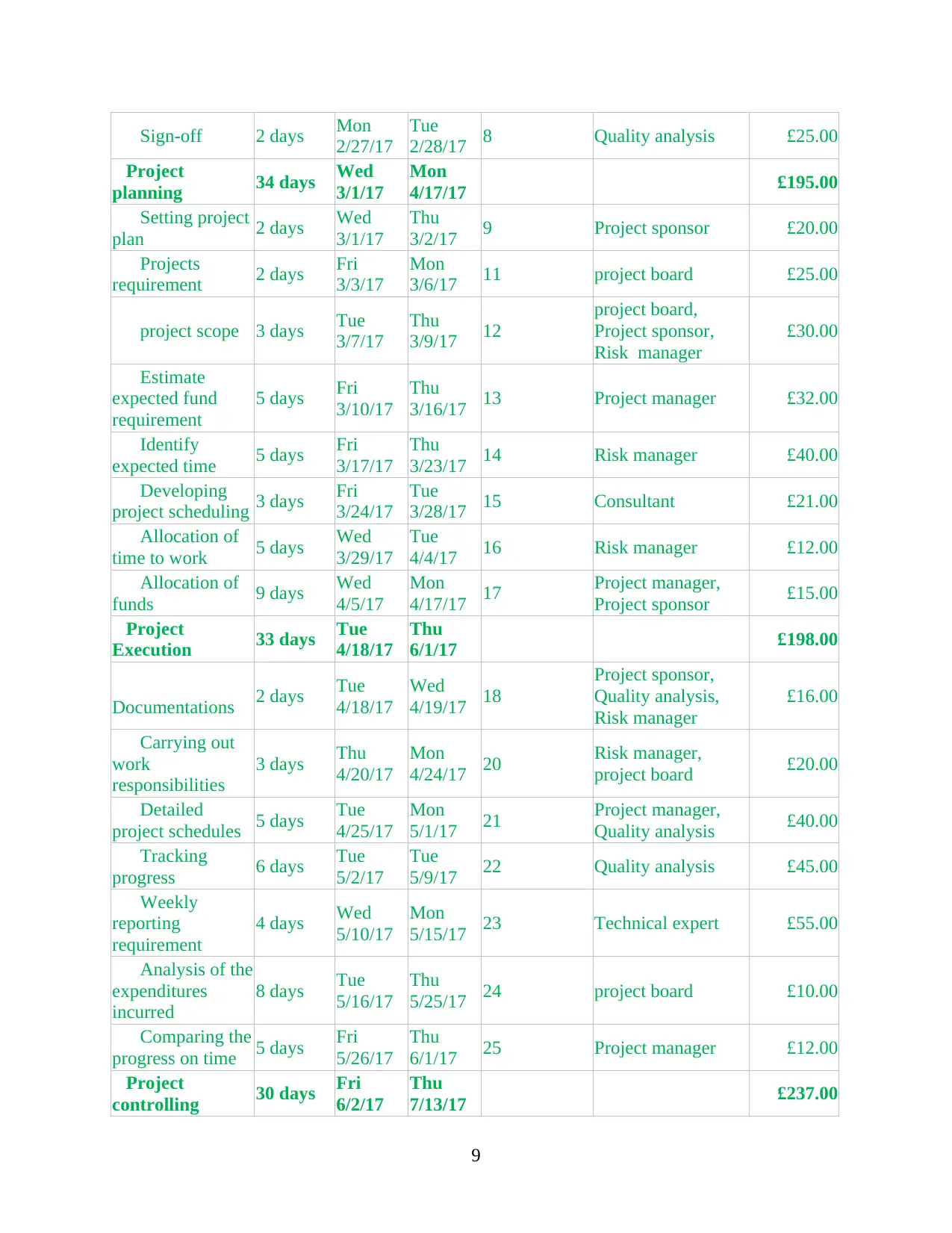
Sign-off 2 days Mon
2/27/17
Tue
2/28/17 8 Quality analysis £25.00
Project
planning 34 days Wed
3/1/17
Mon
4/17/17 £195.00
Setting project
plan 2 days Wed
3/1/17
Thu
3/2/17 9 Project sponsor £20.00
Projects
requirement 2 days Fri
3/3/17
Mon
3/6/17 11 project board £25.00
project scope 3 days Tue
3/7/17
Thu
3/9/17 12
project board,
Project sponsor,
Risk manager
£30.00
Estimate
expected fund
requirement
5 days Fri
3/10/17
Thu
3/16/17 13 Project manager £32.00
Identify
expected time 5 days Fri
3/17/17
Thu
3/23/17 14 Risk manager £40.00
Developing
project scheduling 3 days Fri
3/24/17
Tue
3/28/17 15 Consultant £21.00
Allocation of
time to work 5 days Wed
3/29/17
Tue
4/4/17 16 Risk manager £12.00
Allocation of
funds 9 days Wed
4/5/17
Mon
4/17/17 17 Project manager,
Project sponsor £15.00
Project
Execution 33 days Tue
4/18/17
Thu
6/1/17 £198.00
Documentations 2 days Tue
4/18/17
Wed
4/19/17 18
Project sponsor,
Quality analysis,
Risk manager
£16.00
Carrying out
work
responsibilities
3 days Thu
4/20/17
Mon
4/24/17 20 Risk manager,
project board £20.00
Detailed
project schedules 5 days Tue
4/25/17
Mon
5/1/17 21 Project manager,
Quality analysis £40.00
Tracking
progress 6 days Tue
5/2/17
Tue
5/9/17 22 Quality analysis £45.00
Weekly
reporting
requirement
4 days Wed
5/10/17
Mon
5/15/17 23 Technical expert £55.00
Analysis of the
expenditures
incurred
8 days Tue
5/16/17
Thu
5/25/17 24 project board £10.00
Comparing the
progress on time 5 days Fri
5/26/17
Thu
6/1/17 25 Project manager £12.00
Project
controlling 30 days Fri
6/2/17
Thu
7/13/17 £237.00
9
2/27/17
Tue
2/28/17 8 Quality analysis £25.00
Project
planning 34 days Wed
3/1/17
Mon
4/17/17 £195.00
Setting project
plan 2 days Wed
3/1/17
Thu
3/2/17 9 Project sponsor £20.00
Projects
requirement 2 days Fri
3/3/17
Mon
3/6/17 11 project board £25.00
project scope 3 days Tue
3/7/17
Thu
3/9/17 12
project board,
Project sponsor,
Risk manager
£30.00
Estimate
expected fund
requirement
5 days Fri
3/10/17
Thu
3/16/17 13 Project manager £32.00
Identify
expected time 5 days Fri
3/17/17
Thu
3/23/17 14 Risk manager £40.00
Developing
project scheduling 3 days Fri
3/24/17
Tue
3/28/17 15 Consultant £21.00
Allocation of
time to work 5 days Wed
3/29/17
Tue
4/4/17 16 Risk manager £12.00
Allocation of
funds 9 days Wed
4/5/17
Mon
4/17/17 17 Project manager,
Project sponsor £15.00
Project
Execution 33 days Tue
4/18/17
Thu
6/1/17 £198.00
Documentations 2 days Tue
4/18/17
Wed
4/19/17 18
Project sponsor,
Quality analysis,
Risk manager
£16.00
Carrying out
work
responsibilities
3 days Thu
4/20/17
Mon
4/24/17 20 Risk manager,
project board £20.00
Detailed
project schedules 5 days Tue
4/25/17
Mon
5/1/17 21 Project manager,
Quality analysis £40.00
Tracking
progress 6 days Tue
5/2/17
Tue
5/9/17 22 Quality analysis £45.00
Weekly
reporting
requirement
4 days Wed
5/10/17
Mon
5/15/17 23 Technical expert £55.00
Analysis of the
expenditures
incurred
8 days Tue
5/16/17
Thu
5/25/17 24 project board £10.00
Comparing the
progress on time 5 days Fri
5/26/17
Thu
6/1/17 25 Project manager £12.00
Project
controlling 30 days Fri
6/2/17
Thu
7/13/17 £237.00
9
Paraphrase This Document
Need a fresh take? Get an instant paraphrase of this document with our AI Paraphraser
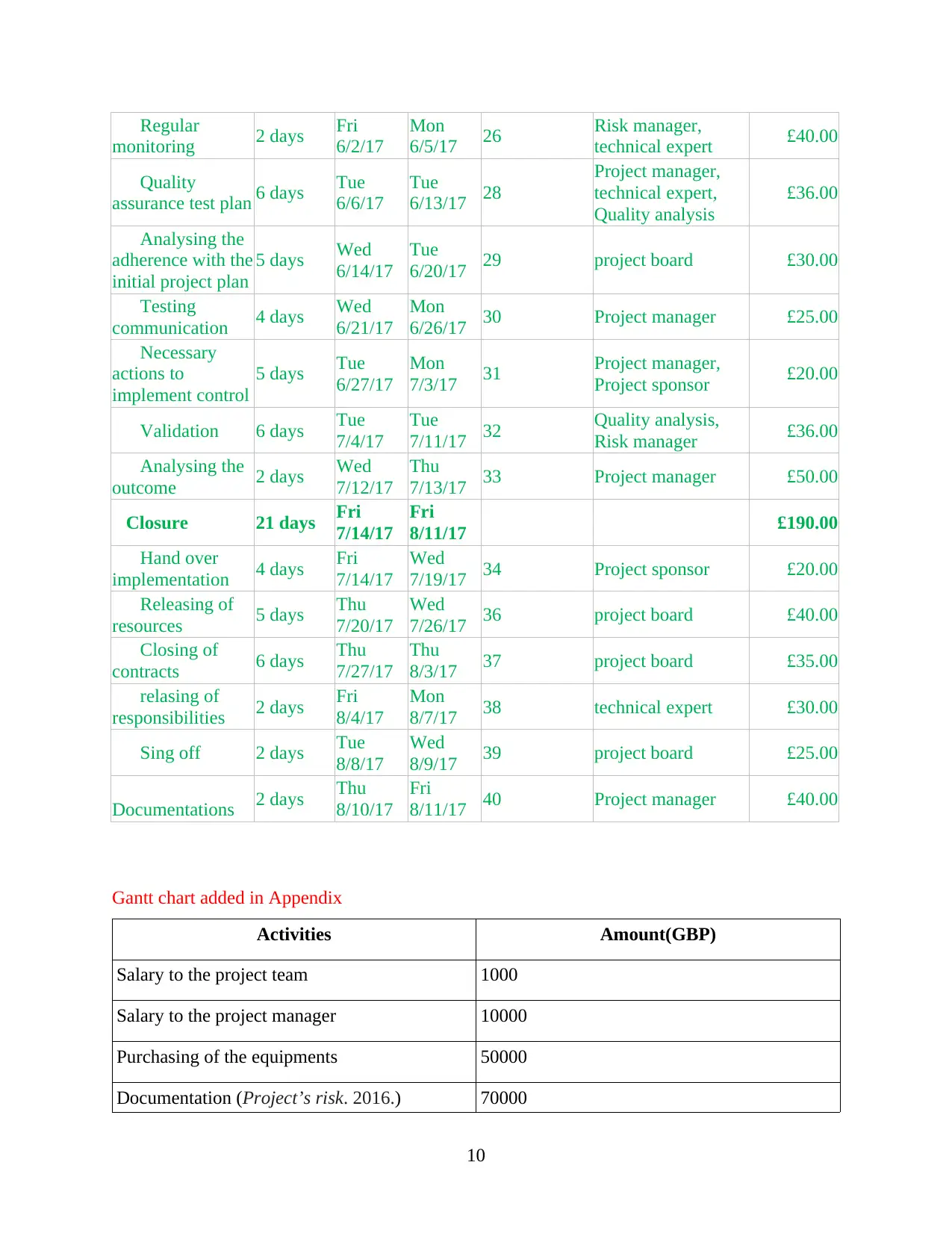
Regular
monitoring 2 days Fri
6/2/17
Mon
6/5/17 26 Risk manager,
technical expert £40.00
Quality
assurance test plan 6 days Tue
6/6/17
Tue
6/13/17 28
Project manager,
technical expert,
Quality analysis
£36.00
Analysing the
adherence with the
initial project plan
5 days Wed
6/14/17
Tue
6/20/17 29 project board £30.00
Testing
communication 4 days Wed
6/21/17
Mon
6/26/17 30 Project manager £25.00
Necessary
actions to
implement control
5 days Tue
6/27/17
Mon
7/3/17 31 Project manager,
Project sponsor £20.00
Validation 6 days Tue
7/4/17
Tue
7/11/17 32 Quality analysis,
Risk manager £36.00
Analysing the
outcome 2 days Wed
7/12/17
Thu
7/13/17 33 Project manager £50.00
Closure 21 days Fri
7/14/17
Fri
8/11/17 £190.00
Hand over
implementation 4 days Fri
7/14/17
Wed
7/19/17 34 Project sponsor £20.00
Releasing of
resources 5 days Thu
7/20/17
Wed
7/26/17 36 project board £40.00
Closing of
contracts 6 days Thu
7/27/17
Thu
8/3/17 37 project board £35.00
relasing of
responsibilities 2 days Fri
8/4/17
Mon
8/7/17 38 technical expert £30.00
Sing off 2 days Tue
8/8/17
Wed
8/9/17 39 project board £25.00
Documentations 2 days Thu
8/10/17
Fri
8/11/17 40 Project manager £40.00
Gantt chart added in Appendix
Activities Amount(GBP)
Salary to the project team 1000
Salary to the project manager 10000
Purchasing of the equipments 50000
Documentation (Project’s risk. 2016.) 70000
10
monitoring 2 days Fri
6/2/17
Mon
6/5/17 26 Risk manager,
technical expert £40.00
Quality
assurance test plan 6 days Tue
6/6/17
Tue
6/13/17 28
Project manager,
technical expert,
Quality analysis
£36.00
Analysing the
adherence with the
initial project plan
5 days Wed
6/14/17
Tue
6/20/17 29 project board £30.00
Testing
communication 4 days Wed
6/21/17
Mon
6/26/17 30 Project manager £25.00
Necessary
actions to
implement control
5 days Tue
6/27/17
Mon
7/3/17 31 Project manager,
Project sponsor £20.00
Validation 6 days Tue
7/4/17
Tue
7/11/17 32 Quality analysis,
Risk manager £36.00
Analysing the
outcome 2 days Wed
7/12/17
Thu
7/13/17 33 Project manager £50.00
Closure 21 days Fri
7/14/17
Fri
8/11/17 £190.00
Hand over
implementation 4 days Fri
7/14/17
Wed
7/19/17 34 Project sponsor £20.00
Releasing of
resources 5 days Thu
7/20/17
Wed
7/26/17 36 project board £40.00
Closing of
contracts 6 days Thu
7/27/17
Thu
8/3/17 37 project board £35.00
relasing of
responsibilities 2 days Fri
8/4/17
Mon
8/7/17 38 technical expert £30.00
Sing off 2 days Tue
8/8/17
Wed
8/9/17 39 project board £25.00
Documentations 2 days Thu
8/10/17
Fri
8/11/17 40 Project manager £40.00
Gantt chart added in Appendix
Activities Amount(GBP)
Salary to the project team 1000
Salary to the project manager 10000
Purchasing of the equipments 50000
Documentation (Project’s risk. 2016.) 70000
10
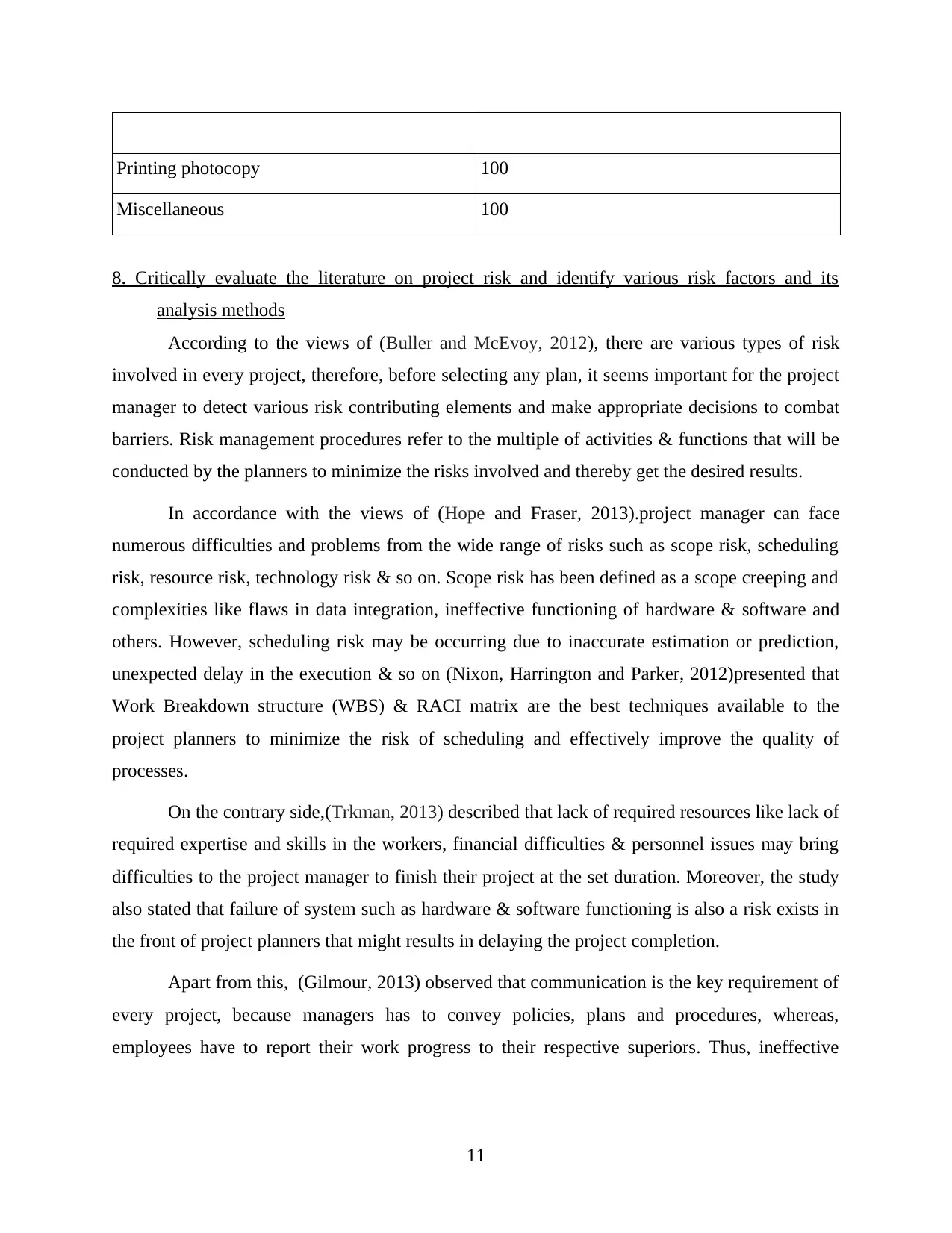
Printing photocopy 100
Miscellaneous 100
8. Critically evaluate the literature on project risk and identify various risk factors and its
analysis methods
According to the views of (Buller and McEvoy, 2012), there are various types of risk
involved in every project, therefore, before selecting any plan, it seems important for the project
manager to detect various risk contributing elements and make appropriate decisions to combat
barriers. Risk management procedures refer to the multiple of activities & functions that will be
conducted by the planners to minimize the risks involved and thereby get the desired results.
In accordance with the views of (Hope and Fraser, 2013).project manager can face
numerous difficulties and problems from the wide range of risks such as scope risk, scheduling
risk, resource risk, technology risk & so on. Scope risk has been defined as a scope creeping and
complexities like flaws in data integration, ineffective functioning of hardware & software and
others. However, scheduling risk may be occurring due to inaccurate estimation or prediction,
unexpected delay in the execution & so on (Nixon, Harrington and Parker, 2012)presented that
Work Breakdown structure (WBS) & RACI matrix are the best techniques available to the
project planners to minimize the risk of scheduling and effectively improve the quality of
processes.
On the contrary side,(Trkman, 2013) described that lack of required resources like lack of
required expertise and skills in the workers, financial difficulties & personnel issues may bring
difficulties to the project manager to finish their project at the set duration. Moreover, the study
also stated that failure of system such as hardware & software functioning is also a risk exists in
the front of project planners that might results in delaying the project completion.
Apart from this, (Gilmour, 2013) observed that communication is the key requirement of
every project, because managers has to convey policies, plans and procedures, whereas,
employees have to report their work progress to their respective superiors. Thus, ineffective
11
Miscellaneous 100
8. Critically evaluate the literature on project risk and identify various risk factors and its
analysis methods
According to the views of (Buller and McEvoy, 2012), there are various types of risk
involved in every project, therefore, before selecting any plan, it seems important for the project
manager to detect various risk contributing elements and make appropriate decisions to combat
barriers. Risk management procedures refer to the multiple of activities & functions that will be
conducted by the planners to minimize the risks involved and thereby get the desired results.
In accordance with the views of (Hope and Fraser, 2013).project manager can face
numerous difficulties and problems from the wide range of risks such as scope risk, scheduling
risk, resource risk, technology risk & so on. Scope risk has been defined as a scope creeping and
complexities like flaws in data integration, ineffective functioning of hardware & software and
others. However, scheduling risk may be occurring due to inaccurate estimation or prediction,
unexpected delay in the execution & so on (Nixon, Harrington and Parker, 2012)presented that
Work Breakdown structure (WBS) & RACI matrix are the best techniques available to the
project planners to minimize the risk of scheduling and effectively improve the quality of
processes.
On the contrary side,(Trkman, 2013) described that lack of required resources like lack of
required expertise and skills in the workers, financial difficulties & personnel issues may bring
difficulties to the project manager to finish their project at the set duration. Moreover, the study
also stated that failure of system such as hardware & software functioning is also a risk exists in
the front of project planners that might results in delaying the project completion.
Apart from this, (Gilmour, 2013) observed that communication is the key requirement of
every project, because managers has to convey policies, plans and procedures, whereas,
employees have to report their work progress to their respective superiors. Thus, ineffective
11
⊘ This is a preview!⊘
Do you want full access?
Subscribe today to unlock all pages.

Trusted by 1+ million students worldwide
1 out of 31
Related Documents
Your All-in-One AI-Powered Toolkit for Academic Success.
+13062052269
info@desklib.com
Available 24*7 on WhatsApp / Email
![[object Object]](/_next/static/media/star-bottom.7253800d.svg)
Unlock your academic potential
Copyright © 2020–2025 A2Z Services. All Rights Reserved. Developed and managed by ZUCOL.




